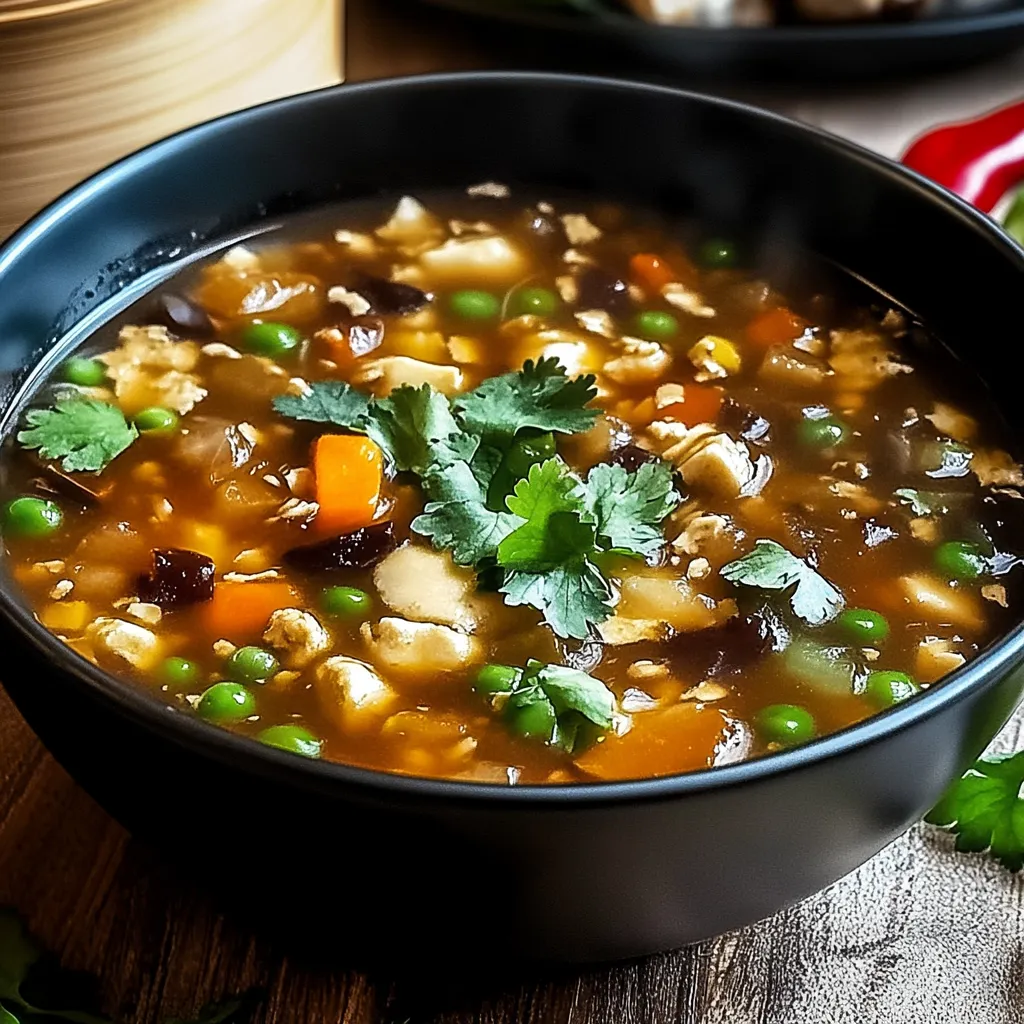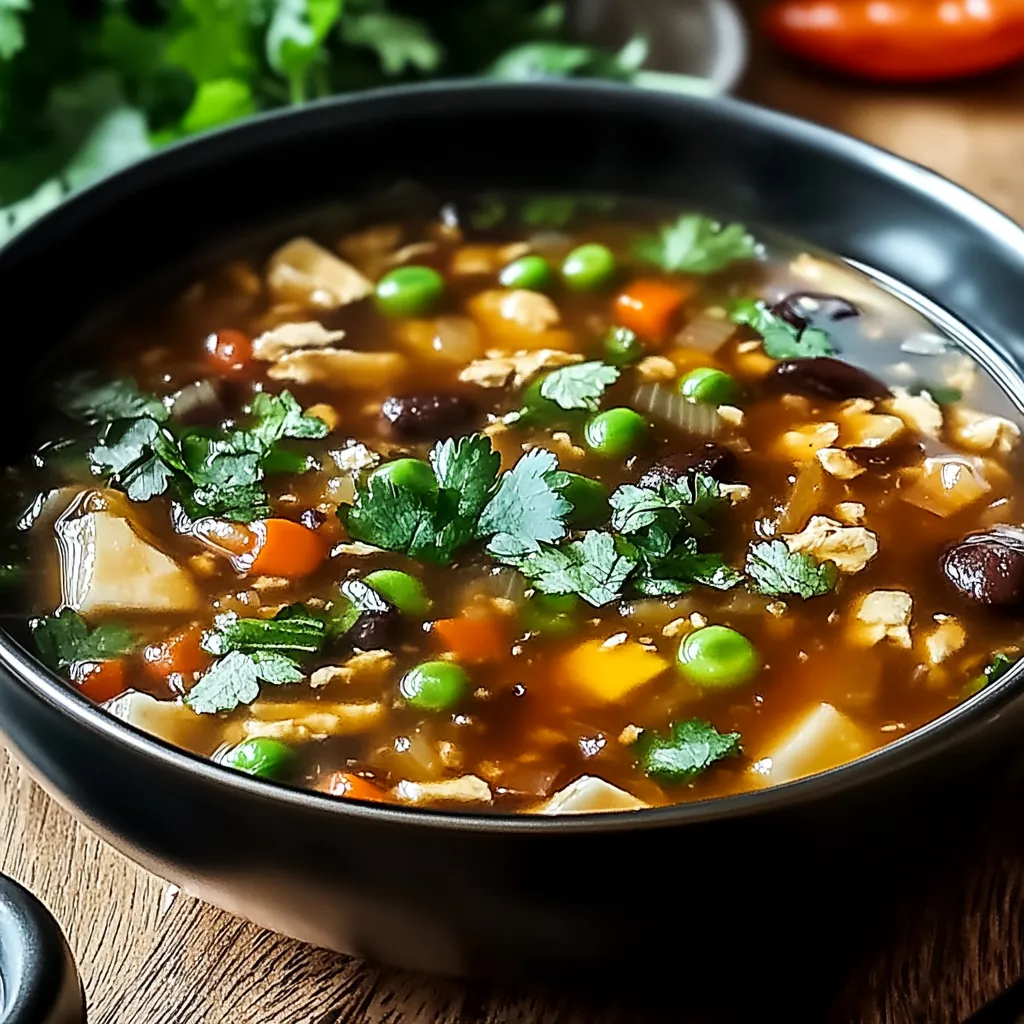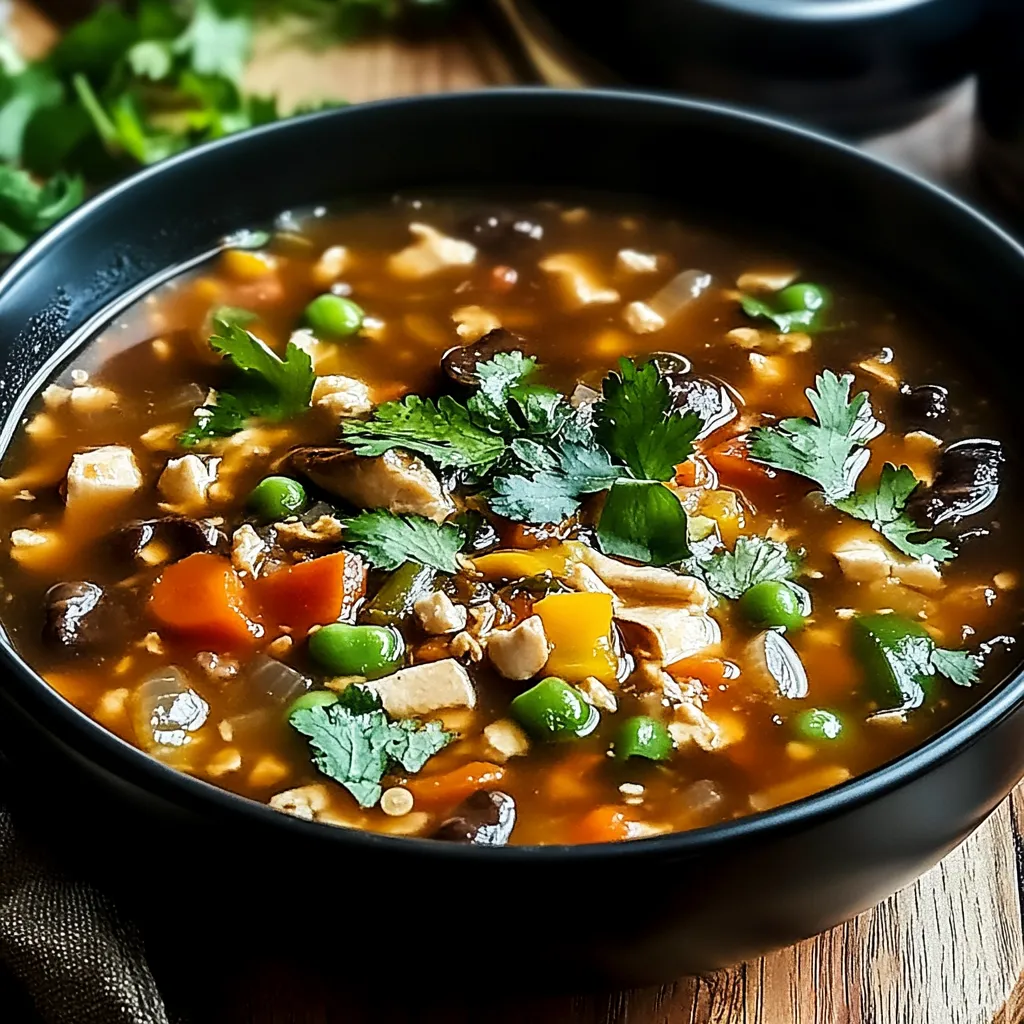 Pin it
Pin it
This hearty Chinese-style hot and sour soup has been my weeknight salvation during cold months for years. The perfect balance of tangy, spicy flavors combined with silky textures creates a restaurant-quality experience right in your home kitchen.
I first discovered this soup when battling a winter cold and was amazed at how the aromatic broth cleared my sinuses and warmed me from the inside out. Since then, it has become my go-to comfort food that impresses guests and family alike without hours of cooking.
Ingredients
- Chicken broth: Forms the foundation of your soup bringing rich savory flavor
- Soy sauce: Adds umami depth and authentic Chinese character
- Rice vinegar: Provides that essential tangy sourness without being overpowering
- Cornstarch: Creates the silky texture that distinguishes hot and sour soup
- Sesame oil: Adds nutty aroma that elevates the entire dish
- Chili garlic sauce: Brings customizable heat that wakes up your taste buds
- White pepper: Adds authentic flavor with a distinct warmth different from black pepper
- Firm tofu: Absorbs flavors while providing protein and satisfying texture
- Mushrooms: Contribute earthy complexity and meaty texture
- Bamboo shoots: Add traditional crunch and authenticity
- Carrots: Provide subtle sweetness and beautiful color contrast
- Eggs: Create delicate ribbons that float beautifully throughout the soup
Step-by-Step Instructions
- Prepare the Base:
- Begin by bringing your chicken broth to a gentle boil in a large pot over medium heat. This creates the foundation for all the flavors to build upon. Once the broth begins to simmer, add the soy sauce, rice vinegar, sesame oil, and chili garlic sauce. Take a moment to taste and adjust the seasonings. The soup should have a pronounced tanginess from the vinegar with a warming heat from the chili sauce. Remember that the flavors will develop further as the soup cooks.
- Add the Vegetables and Tofu:
- Carefully add your mushrooms, bamboo shoots, julienned carrots, and tofu cubes to the simmering broth. The tofu should be added gently to prevent breaking. Allow everything to simmer for 5 to 7 minutes, which gives the vegetables time to soften slightly while still maintaining some texture. The tofu will begin absorbing the flavorful broth during this stage, becoming more delicious with each passing minute.
- Thicken the Soup:
- Make sure your cornstarch slurry is well mixed with no lumps before adding. Pour it into the soup in a steady stream while stirring continuously. This technique prevents clumping and ensures even thickening throughout the soup. Continue simmering for 2 to 3 minutes, allowing the soup to reach a silky consistency that coats the back of a spoon. The soup will thicken further as it cools slightly.
- Add the Eggs:
- Reduce your heat to low to create a gentle simmer. The key to beautiful egg ribbons is drizzling the beaten eggs slowly in a thin stream while stirring the soup very gently with a fork or chopsticks. Move in a circular pattern around the pot rather than stirring vigorously. This creates delicate, silky egg strands that float throughout the soup rather than clumping together. Allow them to cook for about 30 seconds before disturbing.
- Serve and Garnish:
- Ladle your hot soup into preheated bowls to maintain temperature. Sprinkle generously with sliced green onions and fresh cilantro, which add brightness and color to the deep, rich soup. For those who enjoy additional heat, a small drizzle of chili oil on top creates an impressive presentation and allows guests to control their spice level.
 Pin it
Pin it
The white pepper is my secret ingredient for authentic Chinese hot and sour soup. Unlike black pepper that sits on your tongue, white pepper creates a warming sensation that builds gradually. My grandmother always insisted on this specific ingredient, claiming it was what separated homemade soup from restaurant quality, and after years of making this recipe, I completely agree.
Storage and Reheating
This soup stores beautifully in the refrigerator for up to 3 days in an airtight container. The flavors actually develop and improve overnight as the ingredients have time to meld. When reheating, do so gently on the stovetop over medium low heat until just simmering. Avoid vigorous boiling which can cause the eggs to toughen and the tofu to break apart. If the soup has thickened too much during storage, add a splash of chicken broth to reach your desired consistency.
Ingredient Substitutions
This recipe welcomes adaptations based on what you have available. Vegetable broth works perfectly for a vegetarian version. No rice vinegar? White vinegar or even apple cider vinegar can substitute in a pinch. Wood ear mushrooms are traditional but any variety works well shiitake bringing particularly rich flavor. For those avoiding eggs, simply omit them or try drizzling in a thin stream of cornstarch slurry for a similar silky texture. The tofu can be swapped for thinly sliced chicken breast or pork for a meatier variation.
Cultural Significance
Hot and sour soup originated in northern China, particularly in Sichuan province, known for bold flavors and spicy food. Traditionally served at the beginning of meals, this soup was designed to stimulate the appetite with its complex combination of flavors. In Chinese medicine, the warming properties of this soup are believed to help balance the body, especially during colder months. The combination of vinegar and pepper specifically was developed to create a harmonious balance according to traditional health principles.
 Pin it
Pin it
Savor this nourishing bowl of hot and sour soup that warms you to your core and transports you to the heart of Sichuan cuisine.
Frequently Asked Questions
- → How can I make this soup more or less spicy?
You can easily adjust the spice level by increasing or decreasing the amount of chili garlic sauce. Start with less if you're sensitive to heat, and add more at the end if needed. White pepper also contributes to the soup's heat, so adjust accordingly. Offering chili oil as a garnish allows each person to customize their own bowl.
- → Can I make this soup vegetarian or vegan?
Yes! For a vegetarian version, simply substitute vegetable broth for the chicken broth. To make it vegan, also omit the eggs. You can add more vegetables or a plant-based protein like additional mushrooms for extra substance.
- → What types of mushrooms work best in this soup?
Traditional Chinese hot and sour soup often uses wood ear or shiitake mushrooms, but button, cremini, or oyster mushrooms also work well. For the most authentic flavor, dried mushrooms (especially shiitake) can be rehydrated and used, as they deliver a deeper, earthier taste.
- → How do I create the perfect egg ribbons?
The key to beautiful egg ribbons is pouring the beaten eggs slowly into the soup in a thin stream while gently stirring in one direction. Use a fork or chopsticks rather than a spoon. Make sure the soup is at a very gentle simmer, not a full boil, when adding the eggs.
- → How long will leftover soup keep in the refrigerator?
Leftover hot and sour soup will keep well in an airtight container in the refrigerator for 3-4 days. The flavors often deepen over time, making it even more delicious the next day. Reheat gently on the stovetop to preserve the textures.
- → What can I serve with hot and sour soup?
This soup pairs wonderfully with steamed rice, simple stir-fried vegetables, or dumplings. For a complete meal, serve alongside spring rolls or as a starter before a main dish of Kung Pao chicken or vegetable fried rice.
